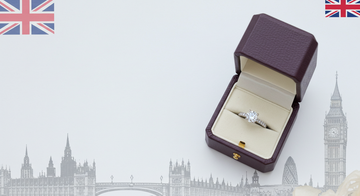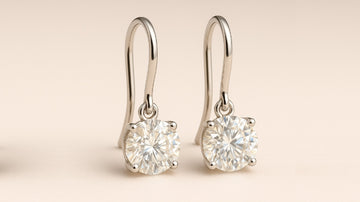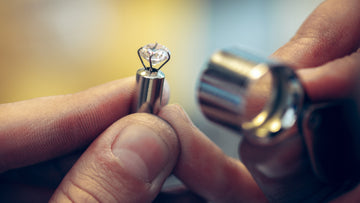The UK’s jewellery market has seen a significant rise in the prices of diamond jewellery in the last few years, which has diverted consumers to look for more affordable diamond alternatives. These options include White Sapphire, White Topaz, Moissanite, Cubic Zirconia, etc.
For good reasons, Moissanite and Cubic Zirconia have become the top contenders. This Moissanite vs Cubic Zirconia comparison guide is made for consumers, especially for those UK buyers who are unable to decide between the two diamond alternatives. But first, let’s start by understanding the stones.
Key Takeaways: Moissanite vs Cubic Zirconia
- Moissanite outlasts Cubic Zirconia - With a hardness of 9.25 on the Mohs scale, Moissanite is almost as durable as diamonds, making it perfect for daily wear.
- Brilliance that shines longer - Moissanite offers fiery rainbow flashes and keeps its sparkle for life, while Cubic Zirconia often becomes cloudy within a year.
- Cost vs. Value - CZ may be cheaper upfront (£5–£30 per carat), but Moissanite (£90–£130 per carat) saves money over time by avoiding replacements.
- Everyday wear or short-term sparkle? - Choose Cubic Zirconia for fashion pieces, but Moissanite for engagement rings, wedding bands, and jewellery you’ll wear daily.
- Ethical and smart choice - Moissanite is lab-created, conflict-free, and offers the closest diamond-like look without breaking the bank.
- The easiest way to spot the difference - Moissanite has stronger brilliance, double refraction, and never loses clarity, unlike Cubic Zirconia.
Overall Verdict:
Moissanite is the better diamond alternative for UK buyers seeking brilliance, durability, and long-term value. Cubic Zirconia remains a budget option but lacks lasting quality.
Understanding Moissanite and Cubic Zirconia: Composition & Origins
What is Moissanite? An artificially created stone composed of silicon carbide (SiC). Its first occurrence was observed in a meteor crash, but the mineral is too rare to be found naturally, so it’s now being artificially produced in volume.
What is Cubic Zirconia? A man-made, synthetic crystal made from zirconium dioxide. It is not like the natural Zircon, which is often confused with Cubic Zirconia.
Key Properties: Moissanite vs Cubic Zirconia
As far as the Cubic Zirconia vs Moissanite comparison is concerned, the differences are noticeable in terms of properties. Let’s take a look.
Durability and Hardness
Moissanite: It ranks 9.25 on the moissanite Mohs scale, which puts it just below diamonds in hardness.
Cubic Zirconia: It ranks around 8 on the Mohs scale, which is even less than that of Moissanite.
Shine and Brilliance
Moissanite: Has a higher refractive index and disperses light into rainbow-like flashes.
Cubic Zirconia: Shine is subdued, and the ‘fire’ is less than that of Moissanite.
Stone Clarity
Moissanite: The stone is clear but can be a little tinted in colours of yellow or grey.
Cubic Zirconia: Appears a lot more like glass from certain angles, but is mostly clear.
Value
Moissanite: Great for value as it doesn’t tarnish or become dull over time, making it a perfect choice for wedding or engagement rings.
Cubic Zirconia: Although stunning, the stone becomes dull, cloudy, and scratched with time, and so the cubic zirconia value is less than that of Moissanite.
Optical Qualities: Moissanite vs Cubic Zirconia
The optical Moissanite vs Cubic Zirconia comparison can be drawn from how both stones perform under different lighting.
Moissanite: Stands out and shines bright in almost any lighting. In daylight, it gives off a sharp, crisp sparkle that closely resembles a diamond. The stone shows intense fire, meaning it reflects flashes of coloured light that can look rainbow-like, under LED light. When placed in candlelight, it emits a warm, romantic glow without losing brilliance.
Cubic Zirconia: Looks bright under indoor lights but lacks the depth of sparkle. It reflects mostly white light, and under LED, it can appear flat or glassy. In low lighting like candlelight, the stone tends to lose its shine quickly.
If you want a stone that retains its shine in any light condition, Moissanite is the perfect choice.
Cost Comparison: Cubic Zirconia vs Moissanite
As Cubic Zirconia is not as durable as Moissanite, the price comparison of Moissanite vs Cubic Zirconia suggests that a 1-carat cubic Zirconia can cost anywhere between £5 and £30.
Moissanite, being more long-lasting and sparkly, is more costly, ranging from £90 to £130.
To give you a real sense of value, here are examples of moissanite wedding rings in the UK and their typical price points:
Hidden Costs: Replacement, Maintenance, and Longevity
The stone, Cubic Zirconia, is easily scratched over time. It may even get cloudy or lose its brilliance within 6 months or a year of daily wear. That means if you buy one, you’ll have to purchase a new one every year, particularly for engagement rings or essential pieces like pendants. The labour cost of resetting stones or cleaning dulled jewellery can be costly too.
Moissanite, in this case, doesn’t demand frequent replacements because of its high durability. You can wear it every day, and it still won’t scratch.
Even though the purchasing price of Cubic Zirconia is less than that of Molissanite, it would be more expensive, along with its ongoing maintenance and replacements.
Value for Money: ROI Over Time
The Cubic Zirconia value is not a great investment when considering ROI. The reason is its short longevity as compared to Moissanite.
How to Tell the Stones Apart
Telling moissanite and Cubic Zirconia apart takes a closer look, especially under proper lighting.
Fire and Brilliance: Moissanite has stronger fire and brilliance, which means it gives off colourful flashes when light hits it, something Cubic Zirconia can’t do.
Refractive Index: When the stones are placed under magnification, Moissanite shows double refraction, making the facets appear slightly doubled. Cubic Zirconia doesn’t do this. Over time, Cubic Zirconia tends to become cloudy due to surface wear, while Moissanite stays clear.
Feel: Touch also reveals a difference: Moissanite feels harder and cooler, while Cubic Zirconia can feel lighter and warmer.
Diamond Test: A diamond tester can help, too. Moissanite sometimes tests as a diamond due to its similar conductivity, but Cubic Zirconia almost always fails the test.
For most people, visual clues like sparkle and clarity are the easiest way to spot the difference. If the stone shows rainbow-like flashes and keeps its shine over time, it’s likely Moissanite. If it dulls quickly, it’s probably Cubic Zirconia. That’s the real difference in the Moissanite vs Cubic Zirconia debate.
Summing Up the Cubic Zirconia vs Moissanite Comparison
A quick overview of all the comparison factors can help you differentiate between the two stones. Refer to the following table for a quick summary
| Feature | Cubic Zirconia | Moissanite |
| Hardness | 8 on the Mohs scale | 9.25 on the Mohs scale |
| Brilliance | Bright, More muted | High, Fiery |
| Cost | Low | Mid-range |
| Durability | Moderate | Excellent |
| Resale Value | Low | Moderate |
| Ethical Sourcing | Yes | Yes |
| Use Case | Fashion, Short-term use. | Daily wear, moissanite jewellery. |
Final Verdict
The final verdict that we can draw from the Cubic Zirconia vs Moissanite comparison is that Moissanite ticks all boxes for consideration. It is not only an ethical alternative to diamonds but also the closest to diamond’s durability. It is a high-value stone that will last long and draw attention for its shiny appearance.
Franc Laurent’s Role in Moissanite Jewellery
At Franc Laurent, we carefully source certified Moissanite from trusted, ethical suppliers and transform these stones into timeless Moissanite jewellery. From moissanite engagement rings and wedding rings to pendants, necklaces, and earrings, each piece is designed with durability, beauty, and everyday wearability in mind.
Our certified Moissanite stones offer a lifetime of durable wear, allowing you to enjoy the brilliance without compromising on quality. Whether marking a special occasion or choosing everyday comfort, our Moissanite jewellery delivers style, strength, and sustainability in one timeless piece.
Frequently Asked Questions
Should I buy Moissanite or Cubic Zirconia?
Moissanite. If you’re looking for a diamond alternative that’s highly durable and long-lasting, then Moissanite would be the right choice. Cubic Zirconia is good too, but only if Moissanite is not in your budget.
How to tell if a Moissanite is high-quality?
A high-quality moissanite will have sharp faceting, strong brilliance, and little to no visible inclusions. It should also be well-cut, with even symmetry and minimal windowing (areas that look see-through). Look for certification to confirm the stone’s grade, especially if it's being used in engagement jewellery.
Why does Cubic Zirconia get cloudy?
Cubic Zirconia develops tiny scratches on its surface from regular wear. These scratches trap oils, dirt, and other residues, which cause the stone to lose its shine and appear hazy. It doesn’t have the hardness to resist this kind of surface damage, which is why it often needs replacing after a few years.
Are fake diamonds considered tacky?
Not really. It depends on the quality and how the stone is worn. Moissanite is a great diamond alternative. It is not a fake diamond but a stone in itself.
Is Moissanite jewellery affordable in the UK?
Absolutely. At Franc Laurent, Moissanite engagement rings start from just £215, with many stunning designs under £500.
Can Moissanite be used in jewellery beyond rings?
Yes. Moissanite’s brilliance and durability make it ideal for all jewellery types. At Franc Laurent, you’ll find Moissanite pendants, moissanite earrings, and moissanite necklaces that bring sparkle to any look.








